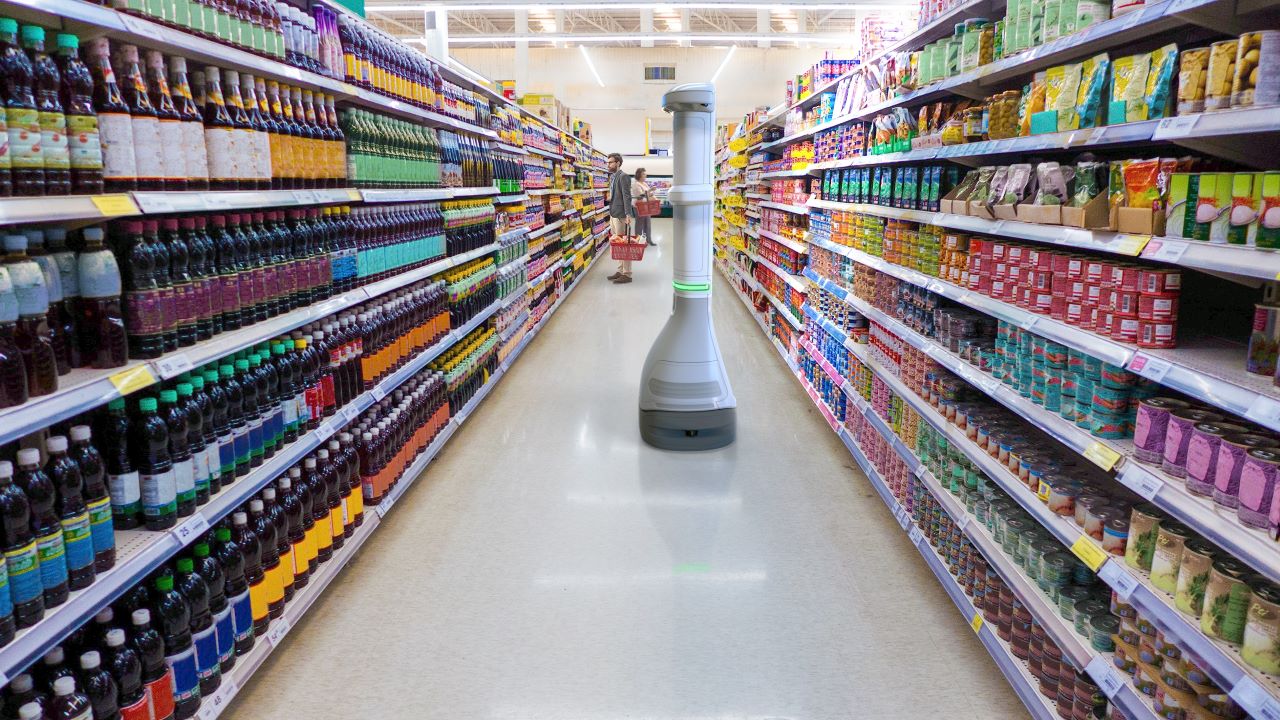
Retailers: Read This Before You Commit to An Intelligent Automation Solution
Every day, more retailers are evaluating the ways in which intelligent automation solutions can help offset the operational burdens levied by the COVID-19 pandemic. With labor pools shrinking and e-commerce fulfillment demands growing, there just aren’t enough store associates to properly manage inventory turnover on shelves and in stockrooms. Plus, there are things that the human eye might miss that smart robots can pick up on in a single pass, as I outlined in my last blog post about the economic benefits of intelligent automation.
Purchasing this type of technology solution is not the same as purchasing a smartphone or even an artificial intelligence (AI) system. Intelligent automation systems require thoughtful consideration of things such as “human robotic interaction” (HRI), safety redundancies and liability insurances – which are not topics that typically come up when talking about mobility solutions or that you’ll readily find disclosed in online spec sheets. That’s why human interaction is vital when you’re evaluating your options. You must pick up the phone, jump on a video chat or – when safe to do so – meet in person with a trusted consultant or partner to understand what it will take to safely, efficiently, securely and cost-effectively deploy intelligent automation in your retail environment.
These are the Must-Ask Questions When Shopping for an Intelligent Automation Solution
First things first, you want to define your desired outcomes. What are you hoping to achieve via intelligent automation? Once that is articulated, you’ll be able to ask sales representatives and solution engineers the right questions about technology design and extensibility. For example, you’ll want to know if:
- the “solution” being offered is just the robot component or if you’ll receive the entire end-to-end platform with your investment. If the “solution” is essentially an a la carte offering, confirm who will provide the additional pieces needed? Will you have to go track those down? Also, confirm if this is an “out of the box” solution or if you’ll need to build any components in house. For example, will you need to develop the app needed to action the tasks identified and executed by the intelligent automation platform?
- this solution features a robust application programming interface (API) that allows you to easily integrate it into your business or if you’ll need to get the data on and off the intelligent automation platform using other methods.
- it is easy to maintain the intelligent automation solution. Also find out who is responsible for software and hardware updates, repairs, etc.
- the robot is as durable as claimed, and if it has issues, that they can be resolved efficiently. (The last thing anyone needs is robot parts all over the store floor.) Also be sure the connection between the robot and the back-end system is robust and won’t break for any reason, whether due to a weak wireless signal or something else.
- this solution been well accepted in the market so far. Though the idea of robots isn’t new, the closest that most people have come to one is on the big screen. Unlike the intelligent automation solutions you might see in a warehouse or manufacturing facility that work alongside – and harmoniously with – people, you need to ensure both customers and staff are comfortable going about their business without directly interacting with the robots they see in retail and grocery stores. In most cases, we don’t want people to have physical contact with retail intelligent automation solutions unless they’re shepherding or managing the robot.
You will also be able to clarify staff resource and competency requirements, such as whether or not:
- you will just need to complete mapping to get the smart robot fully up and running or have to commit to major infrastructure changes in order to integrate the intelligent automation system into your other business systems.
- other actions will need to be taken in order to “launch”, such as laying tape on the ground to guide the robot or complete triangulation tasks.
- you will need to realign more workflows to ensure the data captured by the intelligent automation system is properly distributed to front-line workers and actioned in real time.
- operations be impacted during and after implementation – and if so, how much.
- a technician will be needed to “shepherd” the robot around the store and who will provide that resource if so.
- there be intuitive visual and audible alerts like flashing lights or verbal warnings issued when people get too close to the robot to clue them in and help them make the right move (away from the robot). In other words, you’ll be able to understand the HRI, if and how store staff will be alerted if customers are messing with the robot and how that intervention will be handled.
- you will have access to robotics experts for solution on-boarding, maintenance and management or have to handle everything in house once the solution is deployed. You should confirm who will train your staff, develop policies and monitor performance As well as who will be responsible for support and service of the hardware and software components – your IT team or the solution provider’s IT team. Be sure to understand if you’ll have to send the robot into a depot if an issue arises or if someone will go to you, either in person or virtually.
Of course, anytime you introduce a life-size piece of roving technology into your store environment, human safety must be prioritized and accountability must be maintained. Be sure to confirm:
- what type of safety redundancies are built in to ensure no one gets hurt in your store while this robot is working.
- who carries the burden/liability should an incident occur. Does the vendor/OEM provide insurance that covers losses or will you have to secure that?
- how much support you will receive if there is a safety incident, and how the solution provider will help you recover either from physical or reputation damages.
- what tools are integrated into the system to ensure data security and privacy. (This is a computer vision-based solution, after all. People want to know their faces and actions won’t be broadcast anywhere. Plus, you don’t want to worry about a robot spilling any operational secrets.)
A Final Piece of Advice
Picking the right solution provider is just as important – if not more so – than picking the right solution. There’s a reason why I didn’t answer the above questions or tell you exactly which features and capabilities you need to get from your intelligent automation investment. There isn’t a standard “right answer” or solution that will apply to every situation. Your needs are going to depend on your intended applications and desired outcomes, and even those might change tomorrow.
Ultimately, though, intelligent automation technology won’t deliver the capabilities, benefits and return on investment (ROI) you want or need if not properly implemented or maintained. That’s why the best thing you can do when you start thinking about implementing an intelligent automation solution is to call up a trusted advisor or partner. They can help ensure you are considering all of the important requirements. There may be more than what I listed above – and getting all the answers you need to successfully plan, configure, deploy and manage your technology solution.
How will you know you’ve found someone you can trust? They will help you realize potential applications and outcomes you may not have any been considering. They will be focused on helping you gain more efficiencies pre- and post-deployment. And they will listen versus just talk. Of course, you’ll want to verify their track record with others, too. Ask for references and do your own market research to be sure there aren’t any red flags shared in the public domain.
Now, it is quite possible that individual or company will, in fact, be the solution provider from whom you plan to source the intelligent automation solution. If that’s the case, don’t be afraid to comparison shop – if even you’re confident you’ve found what you needed. If the solution provider you engage with shies away from answering any question or you don’t feel like you’re getting a straight answer, look for someone who will guide you through the buying process and beyond: a partner for life. If they don’t help you better your business and are only worried about closing a sale – then you will struggle to achieve your goals.
Plus, the right solution provider will help you strengthen the business case and secure buy-in from other stakeholders that your decision is in the best interest of your company, employees and customers before you take the next step toward implementation which, for many, is the point of no return.
###
Editor’s Note:
If you’re interested in learning more about the questions you should be asking, reach out to Zebra’s intelligent automation experts. We’ll schedule a discovery session to understand your goals and challenges and help you find a solution that will deliver your desired ROI – and quite possibly benefits you didn’t even know were possible.

Shawn J. Harris
Shawn currently leads go-to-market efforts for Zebra’s SmartSight, as Director of North American Sales. Leveraging Zebra’s over 50 years of experience building purpose-built solutions for retail, SmartSight is Zebra’s inaugural intelligent automation service offering for retail. In this role, Mr. Harris helps Zebra’s retail customers navigate the ever-changing retail landscape and truly digitize their store floors. He provides thought leadership, pragmatic insights and innovative solutions on issues pertaining to the implications of Intelligent Automation and Artificial Intelligence for business strategy, customer experience, inventory visibility and staff productivity.
Mr. Harris’ passion rests in brick-and-mortar and digital retail technology, operations and customer experiences. That has spilled over into supply chain management; he has a strong understanding of the complexity of the timebound matching of supply to demand.
He has been involved with store systems, ecommerce, and order management technologies for over 15 years and has served in various management and consulting roles with tier-one retailers, including TJX Cos, Staples, BJ’s, O’Reilly Auto Parts, and Uniqlo (Fast Retailing). Mr. Harris also founded a luxury menswear brand, which most was known for designing and manufacturing clothing for some of New England’s most regarded corporate executives and professional athletes across the country.
Mr. Harris keeps a keen eye on what’s potentially next, by staying closely involved in the Boston, New York, and Silicon Valley startup communities. He recently served as the program lead for the Startup Leadership Program and has participated in startup programs through XRC Labs, Techstars, MassChallenge and New York Fashion Tech Lab.
Before his career in retail, Mr. Harris helped to start e4eNet as the vice president of global operations. e4eNet was a cloud-based enterprise platform that handled the design for manufacturing process for printed circuit boards (PCBs), e4eNet was ultimately sold to IBM. Prior to e4Enet, Mr. Harris worked for IBM in a number of technical capacities and honorably served in the Army National Guard as an infantryman and armored personnel carrier (APC) driver for eight years. He has a deep curiosity for culture and language. He speaks conversational Japanese, and he has traveled to numerous countries in Europe, Africa, and Asia for business. Mr. Harris earned his MBA from Babson College and a bachelor's degree in management information systems from the University of Massachusetts.






